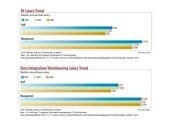Big Data Equals Big Money In Presidential CampaignsBig Data Equals Big Money In Presidential Campaigns
Analytics identify untapped pools of donations, not answers to nagging questions of national policy.


Big Data Talent War: 10 Analytics Job Trends
Big Data Talent War: 10 Analytics Job Trends (click image for larger view and for slideshow)
U.S. political parties might have been among the first--and most aggressive--users of spot surveys, exit polls, and daily measures of the changing opinions of American voters. However, they still are in the rudimentary stages of learning how to find uniquely valuable information from big-data sources or use that information to their advantage, according to specialists in numbers-driven campaign tactics, marketing, and information management.
Long before the term "big data" came into vogue, political campaigns had adopted so many of the techniques marketers use to research and target consumers, the databases they assembled easily could qualify under the three-criterion requirement for big data: volume, velocity, and variety. Not that they called it that, or that they ever dipped too far into the 2.5 quintillion bytes of data created globally every day, according to an estimate from IBM.
They have long had access to many of the critical data bits, however, turning "voting histories, housing values, recreational preferences, automobile ownership and television and Internet viewing habits of individuals. The explosion of consumer data derived primarily from credit card usage and Nielsen ratings," added to other available data, became "a powerful weapon in the hands of politicos," according to Columbia journalism professor and electoral politics expert Thomas B. Edsall.
[ Read FTC Calls For Data Privacy Laws. ]
That weapon is primarily used for nanotargeting, a technique that allows marketers to slice a large population of consumers into dozens or hundreds of segments simply by filtering them through five, 10, or almost any greater number of characteristics rather than only two or three.
For more than a decade, targeted surveys; purchases of demographic and behavioral information from data brokers; and gathering names through Twitter, Facebook or other online sites where voters might state their opinions, has made the digital slicing and dicing more precise.
In 2004, according to the New York Times, the Bush campaign aimed anti-gay-marriage mailings at socially conservative Democratic black voters in an effort to persuade them to vote for Bush rather than Democratic nominee John Kerry.
The filtering and analysis needed to slice off that chunk of voters was advanced for 2004; it might not even qualify as nanotargeting today. Real big-data nanotargeting might sift the electorate in order to find women aged 35 to 45 who are Christian, voted Republican in the last presidential election, live in southern states that voted Republican by only a small margin, list themselves as Independent and as being concerned with social values, but have never contributed to a presidential election campaign. The result could become a mailing list or it could become the base data set for yet another round of analysis designed to separate voters who feel strongly about gay marriage from those who feel strongly about abortion or heterosexual divorce.
It's hard to tell from the outside the exact effect of the Bush anti-gay-marriage campaign, but the percentage of black voters going for Bush in Ohio rose from 9% in 2000 to 16% in 2004, according to the Times.
The details of what campaigns are doing with either data or analytics are fuzzy because campaigns don't brag about their successful techniques until after the election and campaign rules don't generally require campaigns to disclose details of their voter analyses, according to Scott Keeter, director of survey research of the Pew Research Center.
"It's pretty clear it [use of big-data analytics] is much more extensive now than in the past simply because there is a lot more data available about potential voters, which has been integrated into commercially available databases," Keeter said.
Although the methods are still secret, some of the results are leaking out. In August, Fox News reported that part of the reason Mitt Romney's fund raising was outstripping that of Barack Obama was due to Romney's ability to extract donations from even heavily Democratic areas.
A follow-up story in the Associated Press gave credit to a data-mining campaign by consumer-marketing company Buxton Co. of Fort Worth, Texas, which was founded and is led by Tom Buxton, a former Romney colleague from Bain Capital. There is some question about whether Buxton was paid for its work and whether its contribution was legal.
Its methods, as reported by AP, aren't that unusual: "The project relies upon a sophisticated analysis by powerful computers of thousands of commercially available, expensive databases that are lawfully bought and sold behind the scenes by corporations, including details about credit accounts, families and children, voter registrations, charitable contributions, property tax records, and survey responses. It combines marketing data with what is known in this specialized industry as psychographic data analysis, which tries to ferret out Americans' consumer behavior and habits.
An early test analyzed details of more than 2 million households near San Francisco and elsewhere on the West Coast and identified thousands of people who would be comfortably able and inclined to give Romney at least $2,500 or more," according to the AP story written by Jack Gillum.
The Harvard Business Review followed up with an article of its own based not on the impression that the data-mining was an innovation, but that it might have the potential to smoke out the "silent majority" of voters who might feel strongly about one candidate but don't speak out due to peer pressure or natural reticence.
The big data era might allow marketers and political campaigns to gain insight into people's opinions by filtering huge lists according to church attendance or purchasing history, but the biggest impact so far has been in the hunt for donations, according to HBR blogger Julia Kirby.
Campaigns are at least as active at trying to gather voter opinions and broadcast campaign messages through social networks, but the level of uncertainty inherent in data from those sources makes any decisions based on them a little dicey, Keeter said.
The algorithms used to analyze Twitter content have to be trained to recognize negative comments from positive, let alone everything in between, making accurate analysis of millions of Tweets difficult and, potentially, inaccurate, he said.
Big corporations that have led the way in using big-data analytics have also used Twitter to monitor changes in their reputations, but that level of analysis is comparatively simple. Like and hate are fairly easy sentiments to extract; nuances of opinion on budget decisions, security, defense, immigration and the economy are much more difficult, especially when you try to control for the imbalance of opinion on the Internet.
Tweets can come only from a technological elite able to use the Internet regularly, and from those who feel strongly enough about a topic to volunteer their opinion online to strangers, Keeter said. Tweet feeds can be valuable, but they can also be misleading for that reason.
"If you relied only on [social-network opinion-gathering] tools to tell you how the Republican nominating campaign was going a couple of weeks ago, you'd have to think Ron Paul was on his way to victory," Keeter said. "It's not that he has overwhelming support. But he has [numbers of] supporters on these platforms [that are] way out of proportion to the numbers that actually supported him in the elections."
Finding untapped pools of money for campaign donations requires only analysis of comparatively hard facts--age, income, party affiliation, church attendance--most of which came from retail transactions or direct answers to surveys or customer questionnaires, Keeter said. That data is usually much more trustworthy and easy to work with than the unstructured data from social networks.
Except for the Bush campaign's success with conservative African Americans, so far, that seems to be as far as most political campaigns are interested in taking big data or the conclusions it might be able to draw.
See the future of business technology at Interop New York, Oct. 1-5. It's the best place to learn about next-generation technologies including cloud computing, BYOD, big data, and virtualization.
Read more about:
2012About the Author
You May Also Like






